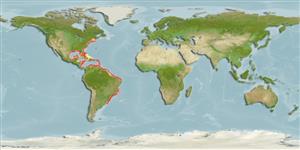Teleostei (teleosts) >
Scombriformes (Mackerels) >
Ariommatidae (Ariommatids)
Etymology: Ariomma: Greek, ari = very, strength, superiority + Greek, omma = eyes (Ref. 45335).
More on author: Fowler.
Environment: milieu / climate zone / depth range / distribution range
Ecology
Marine; demersal; depth range 50 - 500 m (Ref. 26999), usually 100 - 200 m (Ref. 26999). Subtropical; 45°N - 35°S, 98°W - 34°W
Western Atlantic: Canada (Ref. 5951) to Maine, USA and northern Gulf of Mexico to Uruguay. Eastern Atlantic: Senegal to Angola (Ref. 5512).
Length at first maturity / Size / Weight / Age
Maturity: Lm 10.0 range ? - ? cm
Max length : 30.0 cm TL male/unsexed; (Ref. 7251); common length : 23.0 cm FL male/unsexed; (Ref. 47377)
Occurs chiefly on the continental shelf, mostly on muddy bottoms (Ref. 2683). Juveniles occur in surface waters. Feeds mainly on small crustaceans. Forms large schools (Ref. 36543). Adults are demersal or bathypelagic (Ref. 47377).
Oviparous, gonochorous, with pelagic eggs (Ref. 101194).
Robins, C.R. and G.C. Ray, 1986. A field guide to Atlantic coast fishes of North America. Houghton Mifflin Company, Boston, U.S.A. 354 p. (Ref. 7251)
IUCN Red List Status (Ref. 130435: Version 2024-1)
Threat to humans
Harmless
Human uses
Fisheries: minor commercial
Tools
Can't connect to MySQL database fbquizv2. Errorcode: Too many connections
